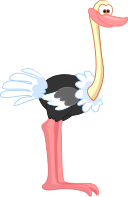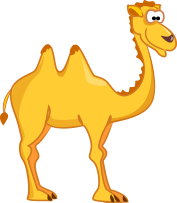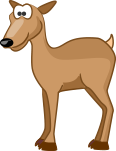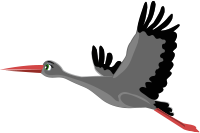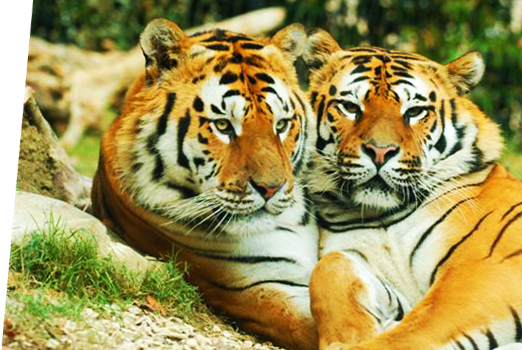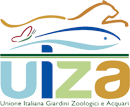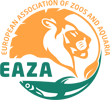Website
University
Research is one of the objectives of Falconara Zoo, which is why it has collaborated with various universities, offering students the opportunity to carry out their three-year, masters, or higher-level thesis.
The main research topics addressed are:
- Ethological observations.
- Study of the effectiveness of enrichments.
- Monitoring in the medical-veterinary field.
- Visitors study on visitor involvement.
- Survey study on the public perception of the zoo.
- Evaluation of educational programs.
Students will be followed by the company tutor.
During the training project, students will have the opportunity to interact with the entire staff of the facility to have a complete view of the mission of a modern zoo.
NB: the student will not come into contact with the animals inside the Park or with their departments.
To send your application form, fill out the datasheet for the thesis/university internship and send it to This email address is being protected from spambots. You need JavaScript enabled to view it.
EAZA campaigns
For more than ten years the Park has actively participated in EAZA campaigns (European Association of Zoos and Aquariums) of which it is a member.
These campaigns are aimed at disseminating the problems associated with the conservation of species at risk of extinction in nature. Each Zoo participating in the campaign actively contributes through fundraising possible thanks to its visitors.
WHICH FISH? 2020-2021
76% of the world's catch is over-exploited. 8 billion kilos of unwanted fish are thrown away every year. If this trend continues, food fishing could collapse by 2050.
It's time to start wondering ... "Which fish do I choose?"
This campaign aims to highlight the impact that human activities based on trade have on the conservation of marine species.
SILENT FOREST 2017-2019
Songbirds in Asia are threatened with extinction due to over-exploitation and deep-rooted exploitation for trade, singing competitions, export, traditional medicine, and their use as food or pets. This campaign aims to save these birds by increasing knowledge, awareness, and commitment to take action for their conservation within and outside the zoo community. The Silent Forest campaign is the first EAZA conservation campaign that focuses primarily on birds, especially Southeast Asian songbirds.
LET IT GROW 2015-2017
The "Let it grow" campaign was launched together with two other European scientific associations: BGCI (Botanic Gardens Conservation International) and ECSITE (European network of science centres and museums). The purpose of the campaign is to protect the biodiversity of our home, promoting the possibility of growth and development of wild plants typical of our natural environments, to recreate the original ecosystems. Anthropogenic pressure, strong urbanization, agriculture, and the introduction of plants and animals of alien species, that is, from places other than those of origin, seriously endanger the survival of the biodiversity of our territories. Thanks to small daily actions, this negative trend could change course. It is worth a try! We “let the plants and animals of our territory grow”.
POLE TO POLE 2013-2015
A campaign launched to make all people aware of the effects of climate change. We often hear about this problem, but what can we actually do? There are small gestures that each of us can make to help reverse the trend: pull the plug, " You pull the plug" too!
EUROPEAN CARNIVORE CAMPAIGN 2008-2010
EAZA has launched a campaign to raise awareness and support scientific research in favour of the conservation of European Carnivores. The presence of predators in nature is synonymous with the well-being of an ecosystem. Man often considers them a threat to livestock and their safety and consequently hunts them or aspires to eliminate them from their place of life, with serious damage to the environmental balance. EAZA zoos, therefore, set out to promote the protection of these endangered animals and the coexistence of humans with these species.
MADAGASCAR CAMPAIGN 2006-2007
This awareness campaign launched to raise funds for the protection of biodiversity and the population of Madagascar, the fourth largest island in the world and a place rich in biodiversity, of global importance for the exclusivity of its habitats.
RHINO CAMPAIGN 2005-2006
This campaign was promoted to involve European zoos and their visitors in the conservation of rhinos. The campaign's goal is to raise funds to support rhino conservation projects, both in Asia and Africa and to provide information on the threats that these animals close to extinction face in the wild.
TIGER CAMPAIGN 2003-2004
This campaign was conceived to safeguard the tiger species that still populate the environments of our planet. The Tiger is "endangered" (Endangered), as shown by the Red List of species at risk of survival, drawn up by the World Union for Conservation of Nature (IUCN). The main causes of the dramatic reduction of this species in nature are the destruction of its habitat, hunting for commercial purposes, and the use of various parts of the body of these animals in oriental medicine.
BUSHMEAT CAMPAIGN 2000-2001
This campaign, one of the first launched by EAZA, aimed to collect a million signatures in all European zoos to ask the Heads of the African States and the European Union itself to stop the illegal trade in bushmeat (such as gorilla and chimpanzee), commonly referred to as "Bush-meat" (meat that comes from the African bush), and to sensitize Zoo visitors to the extremely negative impact that this trade has on the survival of the populations of many wild species.
EAZA - For more information see www.eaza.net
EduZoo
EduZoo is the working group specifically set up by the Italian Union of Zoological Gardens and Aquariums which, through annual meetings, aims to implement a series of educational strategies aimed at:
✅ arousing interest in the natural world,
✅ encouraging awareness of conservation issues,
✅ making people understand the importance of protecting nature, in the broadest sense of the term.
This difficult and stimulating mission is achieved through the use of teaching methodologies that leverage a creative and playful approach capable of stimulating the participation and learning of all those who attend these meetings and workshops.
Environmental education campaigns promoted by UIZA and carried out by the EduZoo working group:
FORESTE SOTTO SOPRA "UPSIDE DOWN FORESTS"
Upside down forests arise from the need to inform and raise awareness of the delicate issue of forests.
The emerged forests occupy 4 billion hectares of global surface, about 30% of continental surfaces, but they are not the only ones, we must also add all those forests that are partially or completely submerged, such as mangroves or kelp forests. We can therefore find forests both below and above water level.
The forests themselves are upside down, turned upside down due to the strong anthropogenic pressure. It is estimated that an area equal to a football field is destroyed every 2 seconds and the causes of deforestation are mainly related to the illegal timber trade, the spread of intensive livestock farming, and the need to have new areas dedicated to agriculture.
BANDITI IN NATURA "NATURE ‘BANDITS’"
The theme of this campaign is poaching, still today one of the most important threats to the survival of animal species.
Our country is often the scene of poaching actions and timely reporting to the authorities can in many cases make the difference for the protection of the species involved.
On the other hand, when we go abroad, our attention to the purchase of souvenirs can weaken the illegal trade in animals and their derivatives.
OCCHIO ALL'ALIENO "BE CAREFUL OF THE ALIEN"
Parrots, turtles, squirrels, and small fish ... aliens, invaders? Who would have thought that!
This campaign was founded in 2014 to inform and sensitize visitors to the Zoological Gardens (through activities, workshops, panels, and posters) on the important issue of invasive alien animal/plant species, a problem raised internationally also by the European Union, which estimates that there are about 10,000 alien species present on our continent.
UNA GIORNATA CON MIC: Millepiedi, Insetti and Co. "A DAY WITH MIC: Millipede, Insects, and Co."
The EduZoo working group wanted to dedicate a day to the memory of a dear friend, Micael, passionate about natural sciences and a great invertebrate expert who for years had worked with them and for them. The festival dedicated to Micael Bolognesi takes place every year on the last Sunday of May in various zoos throughout Italy. This day becomes an opportunity to get to know Millipedes, Insects & Co up close, i.e. the world of invertebrates which together make up 95% of animals on Earth. It is a world that is extremely rich in biodiversity, made of extraordinary colours, extravagant shapes, and unusual behaviours. A day with MIC takes place every year on the last Sunday of May.
Conservation project
Falconara Zoo supports conservation projects "in-situ", i.e. in nature, in the original areas of wild species.
Currently, the Zoo promotes and supports okapi, giraffe and cheetah conservation projects.
The Okapi Conservation Project (OCP) operates in the heart of the Democratic Republic of Congo to protect the natural habitat of the okapi and the indigenous people living in the Okapi Nature Reserve. Proclaimed a UNESCO heritage, the Reserve is one of the areas with the greatest biological diversity in all of Africa. The actions that the Okapi Conservation Project carries out are many, from the promotion of scientific research to the controlling of the territory. This strange mammal is considered "in danger of extinction" by the IUCN Red List of Threatened Species. In about 15 years the number of okapis present in nature has in fact decreased by 50%.
🗓️ 18 October ➡️ World Okapi Day
The Cheetah Conservation Fund (CCF) was founded in 1990 when Dr. Laurie Marker, an American zoologist, decided to found a non-profit organization in Namibia for the protection and reintroduction of these splendid cats into their habitat. The CCF is the most prestigious body in the world for this research, conservation, protection and reintroduction of the cheetah in its natural environment. During the years of activity, the CCF has developed numerous projects aimed at the well-being of felines and other species.
🗓️ 4th December ➡️ World Cheetah Day
The Giraffe Conservation Foundation (GCF) was founded a few years ago to bring to light new knowledge on the biology and conservation of giraffes. Since the late 1990s, the population of giraffes in the wild has gone from 140,000 to 80,000 and is lower than that of elephants. A 40% decrease in just over ten years. This is mainly due to the degradation of its habitat, human activities, and poaching.
🗓️ 21 June ➡️ World Giraffe Day
Volohasy: Bamboo, men, and lemurs.
The Volohasy project was founded through the Department of Life Sciences and Systems Biology (University of Turin) thanks to the support of UIZA and the partners of the Italian Zoological Parks. This initiative intends to combat the loss of forest habitat, which is the leading cause of the extinction of species in Madagascar. The site where the project is located in the protected area of Maromizaha also called the Rainforest of the dragon trees of Madagascar. 13 species of Lemurs, 77 species of birds, 60 species of amphibians, and 20 species of Reptiles live in the areas and need to be protected, the local population is involved in the project, thus promoting the sustainable development of the inhabitants of the forest. Volohasy's goal is to replant a hectare of bamboo forest within the protected area. The whole work plan will be carried out through the monitoring of the reforestation site through a monthly census of the fauna and the training of local personnel specialized in the management of high-value natural resources.
Save the Caissara
From 2011 to 2015 Falconara Zoo promoted a collaboration with the Punta Verde Zoo in Lignano Sabbiadoro, supporting the SAVE THE CAISSARA project.
This project was founded in 2004 thanks to a collaboration between Punta Verde Zoo and the IPÊ (Instituto de Pesquisas Ecológicas), a Brazilian organization operating in the environmental field. Over these years this project has made it possible to carry out field research between the island of Superagui and Ariri (between the State of Paranà and San Paolo in Brazil) in favour of the black-headed Leontopithecus (Leontopithecus caissara), a small monkey belonging to the family of Callitricidae which today lives only and exclusively in that area of Brazil and is not present in captivity.
In the last 10 years:
- a census of the population of Leontopiteco caissara was carried out.
- some groups were monitored through radio collars to understand their habits and the use of space.
- the local population had the opportunity to confront each other, rediscovering traditions to create a satisfactory legal income.
- an ecotourism project was launched to make nature known in its full respect and balance.
The IUCN is evaluating, based on the work carried out in recent years and the data compared, to review the degree of the threat of the Caissara, moving it from "seriously threatened" to "threatened", which would represent a great success and a demonstration that the work done in the last decade has been of great value.
How to contact and how to find us
Parco Zoo Falconara
Via Castello di Barcaglione 10
60015 Falconara Marittima (AN) IT
Tel. +39.071.911312
Fax +39.071.912463
Email This email address is being protected from spambots. You need JavaScript enabled to view it.
 BY CAR
BY CAR
FROM THE A14 MOTORWAY-EXIT ANCONA NORD,
TAKE THE THIRD EXIT ON THE RIGHT OF THE ROUNDABOUT HEADING TOWRADS FALCONARA AND FOLLOW THE SIGNS TO THE ZOO.
Click here to the map

BY TRAIN
3 KMS FROM THE FALCONARA MARITTIMA RAILWAY STATION
BY BUS
3 KMS FROM THE FALCONARA MARITTIMA RAILWAY STATION
 BY BOAT
BY BOAT
10 KMS FROM THE CITY AND PORT OF ANCONA
Click here to the map

BY AIRPLANE
6 KMS FROM THE RAFFAELLO SANZIO AIRPORT OF FALCONARA MARITTIMA
Click here to the map
Animals in the park
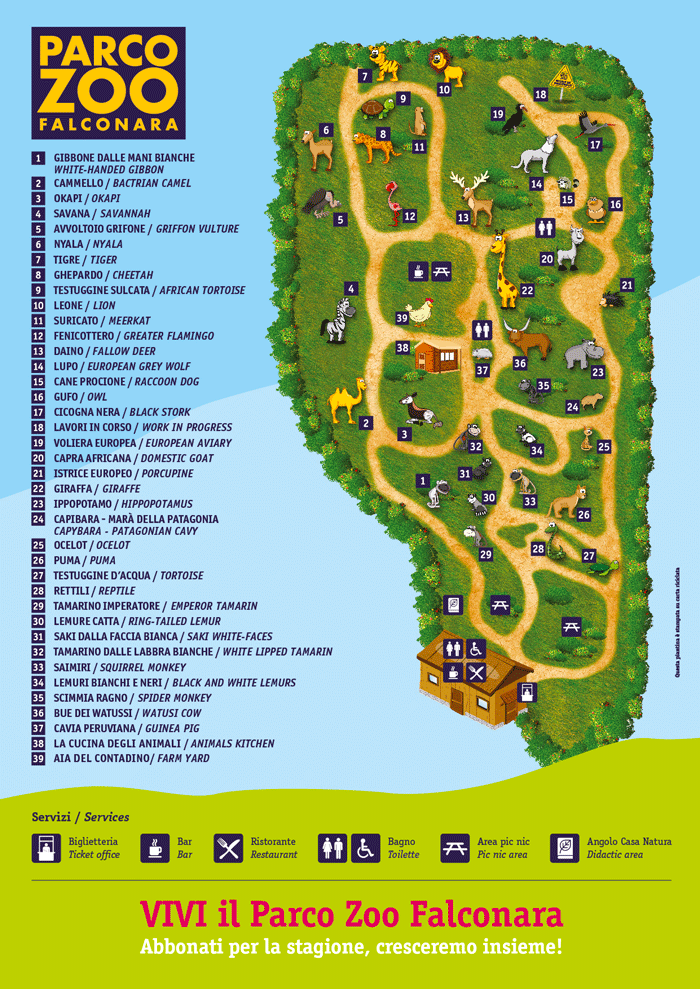
Research and Conservation
The Zoo takes part in some breeding and conservation programmes for endangered species (the EEP) and has been collaborating for years with the State Forestry Corps CITES, giving technical support and hosting confiscated animals. For about ten years the Park has been actively involved in EAZA (European Association of Zoos and Aquarium) campaigns, of which it is a member. These campaigns are aimed at sensitising the conservation of animal species, supported by fundraising, that each Zoo adhering to the campaign carries out with the help of its visitors.
Falconara zoo sustains ‘’in-situ’’ projects, which take place in the native areas of the given species. At the moment, the zoo promotes and sustains the okapi, the giraffe and the cheetah conservation projects.
The Okapi Conservation Project (OCP) operates in the heart of the Democratic Republic of Congo to protect the natural habitat of the okapi and the aboriginals who live in the Natural Okapi Reserves. Proclaimed as a UNESCO heritage, the reserve is one of the areas with the biggest biological diversities in the whole of Africa. The Okapi Project carries out multiple operations, from the promotion of scientific research to the controlling of the territory. This strange mammal is ‘threatened’ with extinction by the IUCN Red List of threatened species. In effect, the okapi specimens present in nature have decreased by 50% in 15 years.
The 18th October is World Okapi Day.
The Giraffe Conservation Foundation (GFC) was born only a few years ago with the aim of giving knowledge about giraffes. Since the end of the 90s to today the population of giraffes in nature has gone from 140.000 to 80.000 and is inferior to that of elephants. A decrease of about 40% in just over ten years. This is due to degradation of the habitat, human activity and poaching.
The 21st June is World Giraffe Day.
The Cheetah Conservation Fund (CCF) was started in 1990 when Dr Laurie Marker, an American Zoologist decided to start a non-profit organization in Zambia for the wellbeing and the reintroduction of this splendid feline to its natural habitat. The CCF is the most prestigious organ regarding research, conservation, wellbeing and the reintroduction of the cheetah to is natural habitat. During its active years, the CCF has developed numerous projects aimed at the wellbeing of felines and other species.
The 4th December is World Cheetah Day.
Volohasy
 Volohasy: Bambù, men and lemurs. The Volohasy project was born through the department of Scienze of Life and Biology of Systems (university of Turin) thanks to the support of UIZA and Italian Zoo partners. The intention of this initiative is to beat the loss of forest habitats, that represent the prime cause of the extinction of species in Madagascar. The area in which the project is localized is the protected area of Maromizaha, also called the Rain forest of the dragon trees of Madagascar.
Volohasy: Bambù, men and lemurs. The Volohasy project was born through the department of Scienze of Life and Biology of Systems (university of Turin) thanks to the support of UIZA and Italian Zoo partners. The intention of this initiative is to beat the loss of forest habitats, that represent the prime cause of the extinction of species in Madagascar. The area in which the project is localized is the protected area of Maromizaha, also called the Rain forest of the dragon trees of Madagascar.
In this area there are 13 species of lemurs, 77 of birds, 60 amphibia and 20 of reptiles to be protected and the local population is taking part in the project, promoting the sustainable development of the inhabitants of the forest. The aim is to replant an hectare of bamboo forest in the protected area. The work on site will be monitored by a monthly census of the fauna and the formation of local people specialized in dealing with natural resources of high value.
![]()
![]()
![]()
University
Research is one of the objectives that modern zoos are pursuing.
Parco Zoo Falconara has for some time been partnered with several Italian universities, providing opportunities for students to pursue their thesis at the Park in order to deepen and improve their techniques ex situ bringing benefits to programmes for the conservation of threatened species and environments.
For universities, zoos represent a huge potential for behavioral studies and verification methods used in the field, in particular with regard to species that are extremely elusive. In fact we have the ability to validate and to experiment with new methods under controlled conditions.
University of Pisa
 Parco Zoo Falconara works by offering its own structure for use and by contributing economically, with the University of Pisa Natural History Museum of the Territory for the implementation of projects like SMELL and L.E.A.V.E.S. Research on olfactory communication of the Lemur Catta.
Parco Zoo Falconara works by offering its own structure for use and by contributing economically, with the University of Pisa Natural History Museum of the Territory for the implementation of projects like SMELL and L.E.A.V.E.S. Research on olfactory communication of the Lemur Catta.
This project is divided into two parts, ex situ population research  (carried out at the Zoo) and application of the results for the in situ research (carried out in Madagascar).
(carried out at the Zoo) and application of the results for the in situ research (carried out in Madagascar).
Save the Caissara
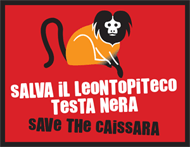 From 2011 to 2015, Parco Zoo Falconara together with Parco Zoo Punta Verde in Lignano Sabbiadoro, have promoted and sustained the SAVE THE CAISSARA project. This project started in 2004 thanks to the collaboration between Parco Zoo Punta Verde and IPE ( Insituto de Pesquisas Ecològicas) a Brazilian organization operating in the environmental field. During these years, this encounter has permitted research to be carried out between the Islands of Superagui and Ariri ( between the states of Parana and Sau Paolo in Brazil) in favour of the Leontopithecus caissara, a small monkey belonging to the callitrichid family, which up to today lives exclusively in that part of Brazil and is not present in captivity.
From 2011 to 2015, Parco Zoo Falconara together with Parco Zoo Punta Verde in Lignano Sabbiadoro, have promoted and sustained the SAVE THE CAISSARA project. This project started in 2004 thanks to the collaboration between Parco Zoo Punta Verde and IPE ( Insituto de Pesquisas Ecològicas) a Brazilian organization operating in the environmental field. During these years, this encounter has permitted research to be carried out between the Islands of Superagui and Ariri ( between the states of Parana and Sau Paolo in Brazil) in favour of the Leontopithecus caissara, a small monkey belonging to the callitrichid family, which up to today lives exclusively in that part of Brazil and is not present in captivity.
In the last 10 years:
- A census on the population of the Leontopiteco caissara has been carried out.
- Some groups have been monitored with the use of radio collars in order to understand their behaviour and use of space.
- The local population has been able to confront themselves, rediscovering traditions to create a satisfactory legal income.
- A project of eco-tourism has been launched in order to make nature in all its full respect and balance known.
The IUCN is valuating, based on the work done in the last few years and comparing data, whether to improve the grade of endangerment of the Caissara, from seriously endangered to endangered, which would be a great success and the demonstration that the work carried out in the last ten years has been of great value.
Parco Zoo Falconara has participated in the following campaigns:
BUSHMEAT CAMPAIGN
TIGER CAMPAIGN
RHINO CAMPAIGN
MADAGASCAR CAMPAIGN
CARNIVORE CAMPAIGN
POLE TO POLE
EAZAFor more information: www.eaza.net
Educational Treks for Schools
The educational tours have been created especially for youngesters to involve them in two fundamental issues of importance, that of ecology and biology through the study of animal material.
The emotion of being able to touch and study skins, furs, skulls, eggs and tusks gives them the opportunity of multi sensorial experiences unknown even in text books. An experience which enables these youngsters to learn and get to know and love nature.
Periods and opening hours
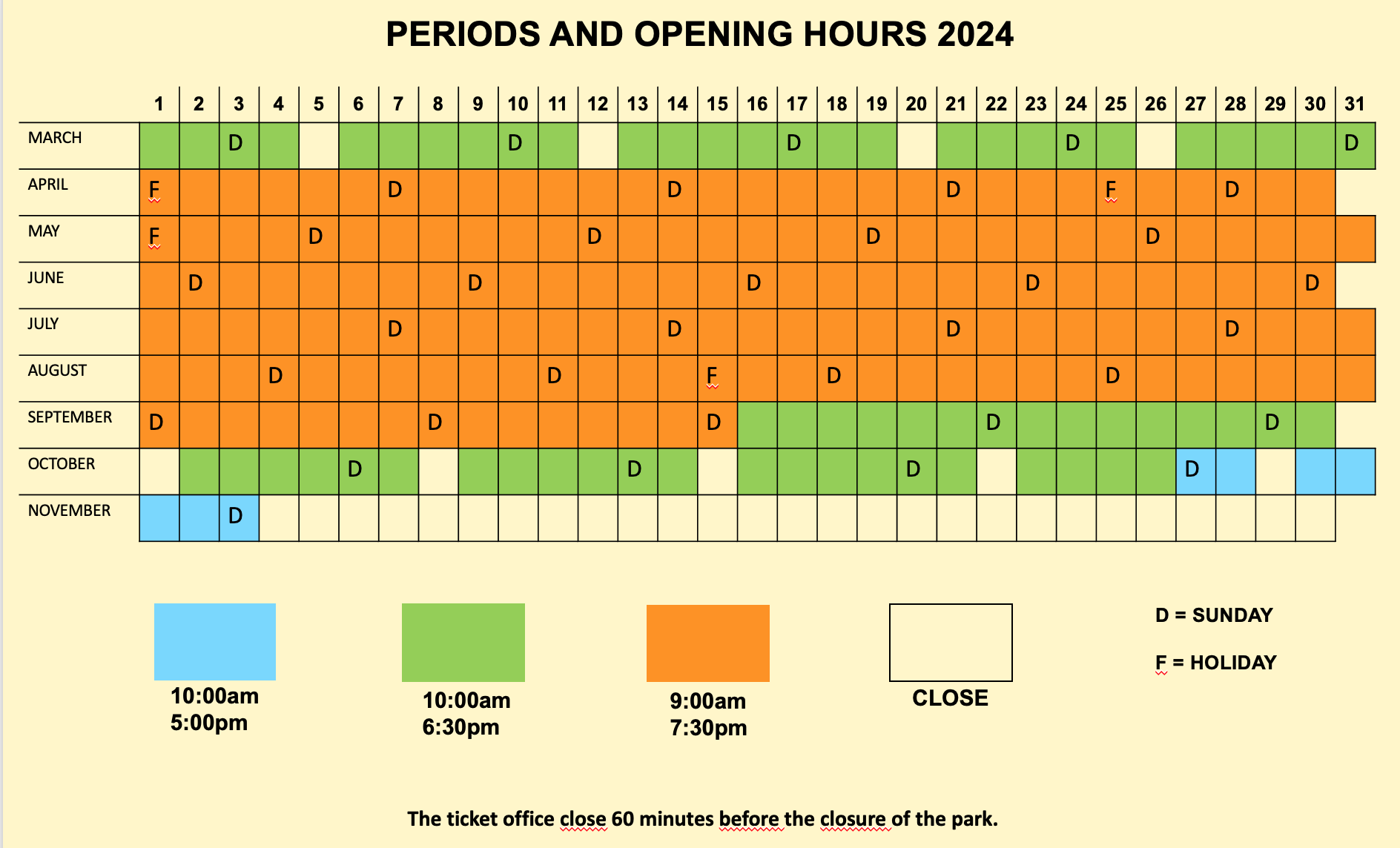
Rates and services
FULL TICKET
|
REDUCED TICKET
|
€ 16,00 |
€ 13,00 |
SERVICES
 |
PARKING |
 |
BAR and RESTAURANT |
 |
TOILET FOR DISABLED |
 |
BABY CHANGING BLOCK |
 |
PIC-NIC AREA |
 |
BOX FOR DOGS FREE USE |
 |
CREDIT CARDS WELCOME |
 |
NO DOGS ALLOWED * |
* The direction inform that the prohibition of bringing dogs into the park is also extended to any other type of animal. Thanks you for your cooperation. |
|||













